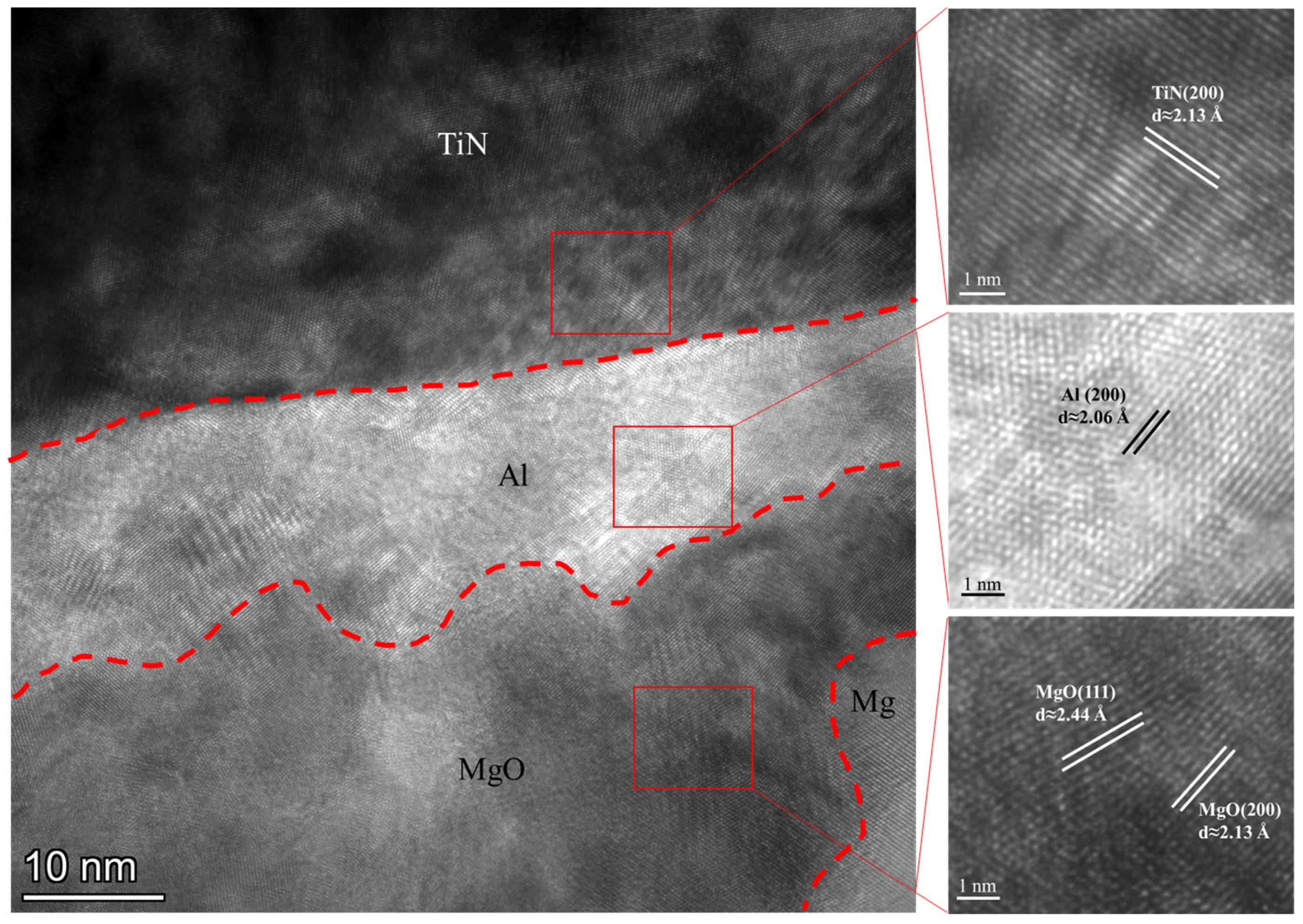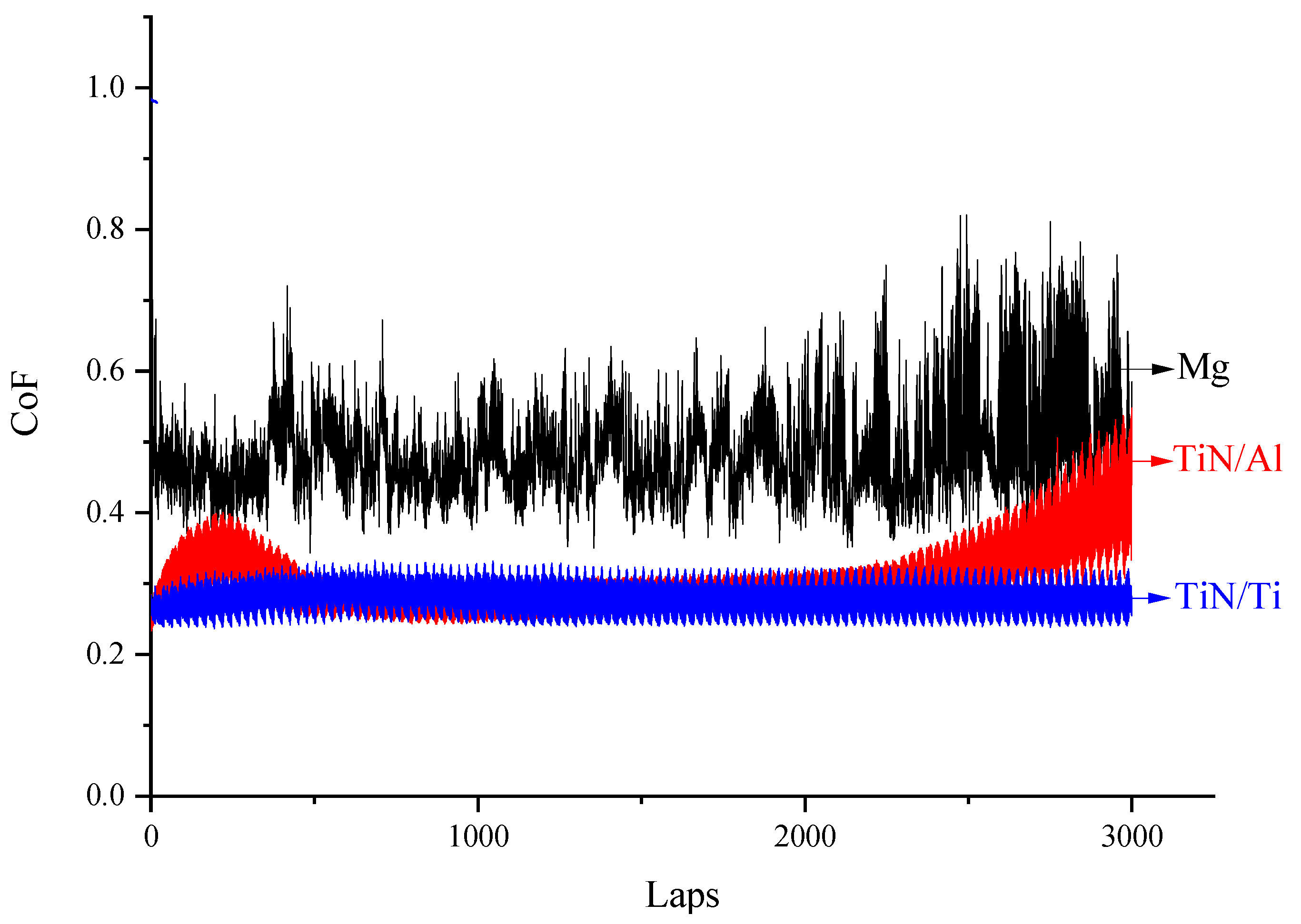Influence of Interlayers on Adhesion Strength of TiN Film on Mg Alloy
Abstract
1. Introduction
2. Experimental
2.1. Sample Preparation
2.2. Deposition Process
2.3. Characterization Methods
3. Results and Discussion
3.1. Scratch Tests
3.2. Friction and Wear
4. Conclusions
- The result of the scratch test indicated that TiN/Ti film had a higher critical load of failure than TiN/Al. The scratch tests applied a single high shear force to the film, and the results indicated that TiN with a Ti interlayer on the ZM21 Mg alloy substrate had a better adhesion strength under a single high shear force.
- The friction and wear tests applied multiple low shear forces to the film, and the results indicated that TiN with a Ti interlayer on the ZM21 Mg alloy substrate had a better adhesion strength under multiple low shear forces.
- Because the CTE of the Ti interlayer was more similar to that of TiN, Mg, and MgO than that of the Al interlayer, and the hardness of the Ti interlayer was larger than that of the Al interlayer, the TiN/Ti film exhibited better adhesion to the Mg alloy substrate than TiN/Al.
Author Contributions
Funding
Institutional Review Board Statement
Informed Consent Statement
Data Availability Statement
Conflicts of Interest
References
- Prasad, S.V.S.; Prasad, S.B.; Verma, K.; Mishra, R.K.; Kumar, V.; Singh, S. The role and significance of Magnesium in modern day research—A review. J. Magnes. Alloys 2022, 10, 1–61. [Google Scholar] [CrossRef]
- Liu, B.; Yang, J.; Zhang, X.; Yang, Q.; Zhang, J.; Li, X. Development and application of magnesium alloy parts for automotive OEMs: A review. J. Magnes. Alloys 2023, 11, 15–47. [Google Scholar] [CrossRef]
- Yang, S.; Zou, B.; Shen, J.; Cai, X.; Wang, Y.; Cao, X.; Zhu, L. Thermal shock behavior of YSZ thermal barrier coatings with a Ni-P/Al/Ni-P sandwich interlayer on AZ91D magnesium alloy substrate at 400 °C. Surf. Coat. Technol. 2019, 367, 278–287. [Google Scholar] [CrossRef]
- Wu, H.; Qasim, A.M.; Xiao, S.; Huang, Q.; Zhang, F.; Wu, Z.; Fu, R.K.Y.; Wu, G.; Chu, P.K. Magnetron-sputtered fluorocarbon polymeric film on magnesium for corrosion protection. Surf. Coat. Technol. 2018, 352, 437–444. [Google Scholar] [CrossRef]
- Surmeneva, M.A.; Surmenev, R.A. Microstructure characterization and corrosion behaviour of a nano-hydroxyapatite coating deposited on AZ31 magnesium alloy using radio frequency magnetron sputtering. Vacuum 2015, 117, 60–62. [Google Scholar] [CrossRef]
- Lin, L.; Tian, Y.; Yu, W.; Chen, S.; Chen, Y.; Chen, W. Corrosion and hardness characteristics of Ti/TiN-modified Ti6Al4V alloy in marine environment. Ceram. Int. 2022, 48, 34848–34854. [Google Scholar] [CrossRef]
- Sheng, L.; Xiao, Y.; Jiao, C.; Du, B.; Li, Y.; Wu, Z.; Shao, L. Influence of layer number on microstructure, mechanical properties and wear behavior of the TiN/Ti multilayer coatings fabricated by high-power magnetron sputtering deposition. J. Manuf. Process. 2021, 70, 529–542. [Google Scholar] [CrossRef]
- Liu, H.; Xu, Q.; Zhang, X.; Wang, C.; Tang, B. Residual stress analysis of TiN film fabricated by plasma immersion ion implantation and deposition process. Nucl. Instrum. Methods Phys. Res. Sect. B Beam Interact. Mater. At. 2013, 297, 1–6. [Google Scholar] [CrossRef]
- Cemin, F.; Abadias, G.; Minea, T.; Lundin, D. Tuning high power impulse magnetron sputtering discharge and substrate bias conditions to reduce the intrinsic stress of TiN thin films. Thin Solid Film. 2019, 688, 137335. [Google Scholar] [CrossRef]
- Li, H.; Sun, P.; Cheng, D.; Liu, Z. Effects of deposition temperature on structure, residual stress and corrosion behavior of Cr/TiN/Ti/TiN films. Ceram. Int. 2021, 47, 34909–34917. [Google Scholar] [CrossRef]
- Subramanian, B.; Jayachandran, M. Characterization of reactive magnetron sputtered nanocrystalline titanium nitride (TiN) thin films with brush plated Ni interlayer. J. Appl. Electrochem. 2007, 37, 1069–1075. [Google Scholar] [CrossRef]
- Chien, H.; Diaz-Jimenez, C.; Rohrer, G.S.; Ban, Z.; Prichard, P.; Liu, Y. The influence of residual thermal stresses on the mechanical properties of multilayer α-Al2O3/TiCxN1−x coatings on WC/Co cutting tools. Surf. Coat. Technol. 2013, 215, 119–126. [Google Scholar] [CrossRef]
- Moridi, A.; Ruan, H.; Zhang, L.C.; Liu, M. Residual stresses in thin film systems: Effects of lattice mismatch, thermal mismatch and interface dislocations. Int. J. Solids Struct. 2013, 50, 3562–3569. [Google Scholar] [CrossRef]
- Alat, E.; Motta, A.T.; Comstock, R.J.; Partezana, J.M.; Wolfe, D.E. Ceramic coating for corrosion (c3) resistance of nuclear fuel cladding. Surf. Coat. Technol. 2015, 281, 133–143. [Google Scholar] [CrossRef]
- Song, M.; Guo, J.; Yang, Y.; Geng, K.; Xiang, M.; Zhu, Q.; Hu, C.; Zhao, H. Fe2Ti interlayer for improved adhesion strength and corrosion resistance of TiN coating on stainless steel 316L. Appl. Surf. Sci. 2020, 504, 144483. [Google Scholar] [CrossRef]
- Hee Kwon, D.; Chang Kang, M.; Suk Kim, J.; Tae Ok, J.; Ho Kim, K. A comparative study on cutting performance of TiN-coated tungsten carbide cutting tool with a cobalt interlayer. Surf. Coat. Technol. 2005, 200, 1933–1938. [Google Scholar] [CrossRef]
- Li, D.; Guruvenket, S.; Hassani, S.; Bousser, E.; Azzi, M.; Szpunar, J.A.; Klemberg-Sapieha, J.E. Effect of Cr interlayer on the adhesion and corrosion enhancement of nanocomposite TiN-based coatings deposited on stainless steel 410. Thin Solid Film. 2011, 519, 3128–3134. [Google Scholar] [CrossRef]
- Wang, X.; Sui, X.; Zhang, S.; Yan, M.; Lu, Y.; Hao, J.; Liu, W. Impacts of the a-Si:H interlayer nanostructure on the adhesion of the thick DLC coatings prepared by PECVD. Appl. Surf. Sci. 2021, 565, 150539. [Google Scholar] [CrossRef]
- Jiang, C.L.; Zhu, H.L.; Shin, K.S.; Tang, Y.B. Influence of titanium interlayer thickness distribution on mechanical properties of Ti/TiN multilayer coatings. Thin Solid Film. 2017, 632, 97–105. [Google Scholar] [CrossRef]
- Xie, W.; Zhao, Y.; Liao, B.; Wang, S.; Zhang, S. Comparative tribological behavior of TiN monolayer and Ti/TiN multilayers on AZ31 magnesium alloys. Surf. Coat. Technol. 2022, 441, 128590. [Google Scholar] [CrossRef]
- Li, D.; Cui, Z.-q.; Yang, Q.-x.; Sun, B.; Sun, M.-h. Microstructure and property of friction stir welding joint of 7075Al and AZ31BMg. J. Shanghai Jiaotong Univ. (Sci.) 2012, 17, 679–683. [Google Scholar] [CrossRef]
- Lenz, B.; Hasselbruch, H.; Großmann, H.; Mehner, A. Application of CNN networks for an automatic determination of critical loads in scratch tests on a-C:H:W coatings. Surf. Coat. Technol. 2020, 393, 125764. [Google Scholar] [CrossRef]
- WebElements. The University of Sheffield and WebElements Ltd, UK. Copyright 1993–2023 Mark Winter. Available online: https://www.webelements.com/ (accessed on 5 December 2023).
- Yanfeng, W.; Zhengxian, L.; Haonan, W.; Jihong, D.; Changwei, Z. Effect of Multilayered Structure on Properties of Ti/TiN Coating. Rare Met. Mater. Eng. 2017, 46, 1219–1224. [Google Scholar] [CrossRef]
- Gerth, J.; Wiklund, U. The influence of metallic interlayers on the adhesion of PVD TiN coatings on high-speed steel. Wear 2008, 264, 885–892. [Google Scholar] [CrossRef]







| MgO (PDF#75-0447) | Al (PDF#01-1180) | Ti (PDF#01-1197) | TiN (PDF#87-0628) |
|---|---|---|---|
| 2.44 Å | 2.33 Å | 2.56 Å | 2.45 Å |
| 2.11 Å | 2.02 Å | 2.34 Å | 2.12 Å |
| 1.49 Å | 1.43 Å | 2.24 Å | 1.50 Å |
| CTE (×10−6/°C) | E (GPa) | ν | HV (MPa) | |
|---|---|---|---|---|
| TiN | 9.35 | 251 | - | - |
| Ti | 8.6 | 116 | 0.32 | 970 |
| Al | 23.1 | 70 | 0.35 | 167 |
| Mg | 8.2 | 45 | 0.29 | - |
| MgO | 13.8 | 310 | - | - |
Disclaimer/Publisher’s Note: The statements, opinions and data contained in all publications are solely those of the individual author(s) and contributor(s) and not of MDPI and/or the editor(s). MDPI and/or the editor(s) disclaim responsibility for any injury to people or property resulting from any ideas, methods, instructions or products referred to in the content. |
© 2024 by the authors. Licensee MDPI, Basel, Switzerland. This article is an open access article distributed under the terms and conditions of the Creative Commons Attribution (CC BY) license (https://creativecommons.org/licenses/by/4.0/).
Share and Cite
Liu, H.; Li, J.; Ma, D.; Jiang, X.; Xie, D.; Leng, Y. Influence of Interlayers on Adhesion Strength of TiN Film on Mg Alloy. Coatings 2024, 14, 121. https://doi.org/10.3390/coatings14010121
Liu H, Li J, Ma D, Jiang X, Xie D, Leng Y. Influence of Interlayers on Adhesion Strength of TiN Film on Mg Alloy. Coatings. 2024; 14(1):121. https://doi.org/10.3390/coatings14010121
Chicago/Turabian StyleLiu, Huaiyuan, Jialin Li, Donglin Ma, Xin Jiang, Dong Xie, and Yongxiang Leng. 2024. "Influence of Interlayers on Adhesion Strength of TiN Film on Mg Alloy" Coatings 14, no. 1: 121. https://doi.org/10.3390/coatings14010121
APA StyleLiu, H., Li, J., Ma, D., Jiang, X., Xie, D., & Leng, Y. (2024). Influence of Interlayers on Adhesion Strength of TiN Film on Mg Alloy. Coatings, 14(1), 121. https://doi.org/10.3390/coatings14010121








